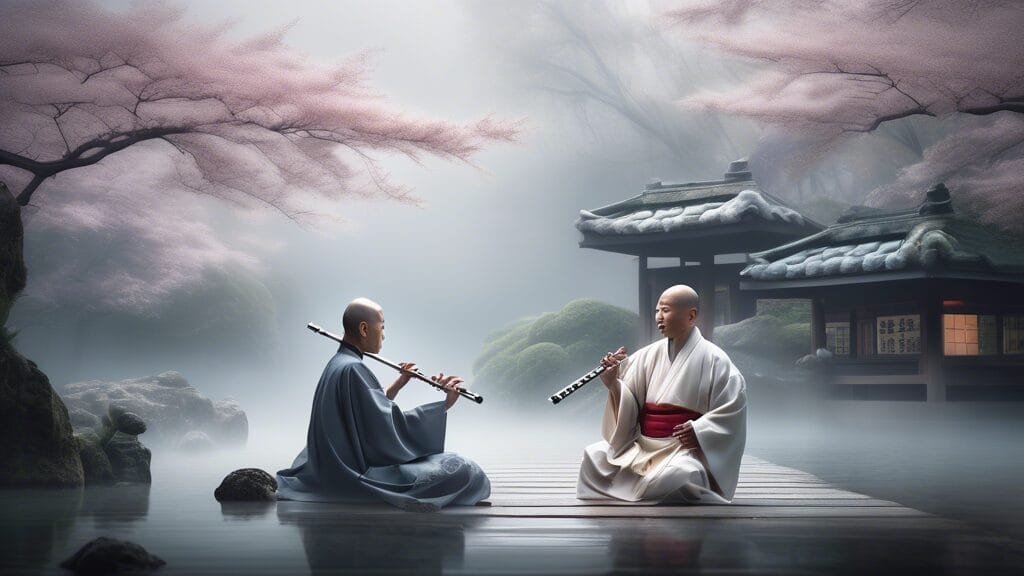Flutist and Japanese Monk Chant Artist Create a Musical Nirvana
You ever find yourself yearning for a slice of serenity in this noisy world? Oh, I know I do! Picture this: a flutist teaming up with an enigmatic Japanese monk chant artist, spinning a musical tapestry so ethereal, it could just float you onto a cloud. Sound like a melodious dream, right?
The Komuso Monks: A Symphony of Silence
Let’s take a marvellous journey back in time to the Edo period of Japan. The Komuso monks, those roving spirits of tranquility, were members of the Fuke sect of Zen Buddhism. These fellas weren’t your average monks—nope, they were masters of the shakuhachi flute. Picture a monk sporting a unique straw basket, a tengai, over his head. It wasn’t a fashion faux pas but rather a symbol of detachment, serving as a reminder to the world to keep a respectful distance. Who knew style could be so spiritual?
Now the shakuhachi isn’t just any flute. It’s a bamboo wonder, perfectly tuned to the minor pentatonic scale, known for drawing listeners into a meditative trance. These monks didn’t simply play music; they orchestrated mindfulness itself. They’d wander the Japanese landscape, seeking alms and sharing spiritual melodies in a practice known as suizen, essentially meditation through music. Ever tried zoning out with some zen music? It isn’t too far off.
Flutist and Japanese Monk: Flute’s Role in Spiritual Awakening
Honkyoku, the original compositions played on the shakuhachi, were more than notes and scales. They were spiritual journeys—meditative voyages encapsulated in sound. Can you imagine reaching enlightenment one breathy note at a time? Now that’s the type of mindfulness I’d sign up for!
These tunes were so essential that Komuso monks were given special travel permissions in what was a strict feudal society. Apparently, even shoguns couldn’t resist the siren song of these bamboo maestros. Interestingly, some monks were rumored to be spies. Who knew serenity could have a side hustle?
Flutist and Japanese Monk: From the Past to the Present
Sadly, the Fuke sect was officially nixed during the Meiji Restoration, a time when ‘traditional’ took a backseat to modernization. But, like all good stories, this one didn’t end there. The soulful echoes of shakuhachi continued, passed on by former monks and absorbed by secular audiences.
Flutist and Japanese Monk: The Shakuhachi Renaissance
Fast forward to today, and you’ll find that the melodies of the shakuhachi have transcended gender and cultural boundaries. Once a dominion of monks, now even women are immersing themselves in this musical art form, engaging with its rich traditions. It’s a testament to the universal appeal of spiritual sound—proof that music truly knows no boundaries.
Flutist and Japanese Monk: Creating Modern-day Musical Nirvana
So, imagine combining the mystical charm of a shakuhachi maestro with a contemporary flutist’s flair. It’s a cross-cultural cocktail of creativity and calm. Together, they weave a soundscape that is less about impressing and more about immersing—a sonic nirvana, if you will. Now, I’d venture to say that’s a collaboration that could lure even the busiest bees into a moment of peace.
Interested in creating your own slice of musical nirvana? Why not pop in some zen music during your next commute or brew some calming tea while mellifluous flutes waft through your space? It might just whisk you away into a world of tranquility, even if just for a few fleeting moments. Who knows, you might find yourself inching closer to enlightenment, one note at a time.
Until then, keep searching for those little moments of zen. With a world as busy as ours, they’re worth their weight in gold—or perhaps bamboo.





















